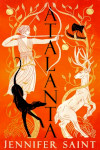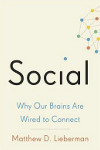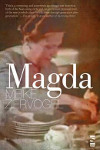Susan Cain – Quiet
Posted 4th February 2013
Category: Reviews Genres: 2010s, Science, Social
13 Comments

For too long we’ve been silent about being silent.
Publisher: Broadway (Random House)
Pages: 266
Type: Non-Fiction
Age: Adult
ISBN: 978-0-307-35215-6
First Published: 2012
Date Reviewed: 29th January 2013
Rating: 4.5/5
Cain explores the history of personality and details experiments and social situations to tell her readers why introverts are important and why they’ve been relegated to second-class citizen status.
Quiet is a rather good, often provocative book that seeks to change the way the world works. Drawing on her personal experience and research, Cain has compiled a thorough document that is both an explanation and a manual for change.
The word personality didn’t exist in English until the eighteenth century, and the idea of “having a good personality” was not widespread until the twentieth.
Cain begins by explaining how there hasn’t always been this conscious split in the western culture, between those who are quiet and those who are louder. It is very interesting, however she doesn’t allow the facts of this to be the focus of her book, in other words her aim is not to go back to the days when to be quiet was preferred, rather it is to create a balance in society where both extroverts and introverts are valued equally. The focus is the overall way in which society has come to value the traits of extroverts, for example that teamwork and the insistence that prospective employees have people skills has caused a skew, leaving introverts at a loss, literally, and favouring a sector of society that, Cain says (and uses evidence to back up) accounts for at the most two thirds of the population.
If we assume that quiet and loud people have roughly the same number of good (and bad) ideas, then we should worry if the louder and more forceful people always carry the day.
Cain highlights the fact that introverts are often better off working alone as opposed to in teams, that team-building days and brainstorming sessions can make it appear as if they have nothing to contribute. Indeed one of Cain’s hopes is that society will not be so obsessed in future with open-plan offices. And in case anyone is reading the book and thinking that she is wrong in her suggestions, Cain spends a chapter looking at other cultures (as opposed to the US) and how they value introversion more. She looks at how Chinese Americans function in American schools and the way they feel they must adapt – and, of course, how they feel America is does it wrong sometimes. This is not to say that some white Americans don’t feel this way, but in highlighting an obviously different cultural group Cain is able to enforce her point.
A big part of the book, even if it is only most obvious at the end, is Cain’s wish to impart teaching ideas and methods for parents to better support their children. For example, Cain describes the extreme of extroverted parents who seek medication for their child, not understanding why the child is quiet. She suggests how classrooms could work better and speaks of how school is so important to get right, how teachers should stop including on report cards the wish that a child would speak more. This is an understandable part of the book but due to its focus on children it could be off-putting for the childless reader or simply just a reader looking for something more adult-orientated. It’s true that a great deal of the book looks at adults, but there isn’t the same dedication in those parts as there is this latter section.
However the main area of the book that is an issue is the bias. Although it is obvious that this book will be quite subjective, the way in which Cain pushes for the rights of introverts can be rather strong, even for the introverted reader. Cain does a great job of being balanced and talks of how both personality types are important, but there are occasions where she becomes a bit of a preacher and denigrates extroverts. If this book was targeted only to introverts that wouldn’t be so much of a problem, it would be more of a book for “bigging up” a reader, but as it is plain that the author plans for anyone to find it accessible, these moments of sudden power are not appropriate.
As Americans moved into cities, working with strangers was needed.
The prospective reader may be interested to know that besides the obvious focus on the artistically inclined – the writer who holes themselves up in their study – there is a great deal of time spent on famous figures in technology, science (this beyond those conducting experiments), and politics. Thus the book would appeal to people who look up to the various leaders in computing, and there is time spent documenting the lead up to black freedom.
Quiet is quiet by nature, but the book has its loud moments. It may not always be objective but at least the intentions of the author make understandable, if not quite acceptable. The few quizzes in the book allow those on the fence to find out who they are in the context of the material. It’s true that there is some repetition in the book, phrases and ideas repeated more than a couple of times, but overall the product is a success. The book will appeal to anyone who considers themselves, well, quiet, shunned by their peers and interested in changes. It will also appeal to teachers looking for insight, and also extroverts – as long as the bias doesn’t put them off (this is the reason the bias is such an issue, because this sort of book needs to be accessible to all). Will it change the world? Who knows? But it might just change a life or two.
I received this book for review from Crown Publishers.
Related Books
Mira Lyn Kelly – Waking Up Married
Posted 28th January 2013
Category: Reviews Genres: 2010s, Domestic, Romance
Comments Off on Mira Lyn Kelly – Waking Up Married
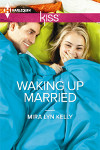
Going to the chapel and we’re going to get married.
Publisher: Harlequin
Pages: 167
Type: Fiction
Age: Adult
ISBN: 978-1-4603-0146-3
First Published: 2012
Date Reviewed: 18th December 2012
Rating: 3.5/5
When Connor finds Megan throwing up in his Vegas hotel bathroom, he realises things aren’t quite as good as he’d hoped, but he didn’t think that Megan would have forgotten the night before. Having approached him in order to silence her friends’ goading, Megan agreed to spend the evening with him, and, when it was obvious that despite first impressions the two strangers were incredibly compatible, she’d agreed to marry him, that night. It made sense – both were disillusioned with the idea of love, but both wanted children (in fact Megan was planning to opt for artificial insemination) and Connor especially wanted a partner who would fit his busy life as the founder of a big business. But now Megan is asking for a divorce that Connor doesn’t want to agree to so instead he proposes a trial marriage. Because they’re perfect for each other, right?
Waking Up Married is a predictable and familiar story told in an often different and very fun way. Based on ideas other books have used, the novel makes for an easy and fast read whilst offering a little to think about, too.
The characters, however, may be considered a let-down. At the beginning both are strong and confident, individuals who know what they want. Neither is the sort of person the other would usually go for, their lives being so different, but Kelly is brilliant at showing the reader how well they fit together, the sort of quick friendship that is echoed by the phrase “I feel I’ve known you all my life”. And because there are no expectations of romance at this point, it works very well. Megan is a particularly interesting character of the independent-woman variety, and Connor determined but respectful. The chemistry sizzles even when there is no contact and the idea that these two people are perfect for each other practically leaps off the page. By all accounts the content that follows the first flashback ought to have been very good.
But unfortunately, Waking Up Married suffers from a major issue. Megan agrees to live with Connor, seeing that although the idea of uprooting her life for a drunken marriage is crazy, Connor is correct in his reasoning that their relationship could very well work. The book goes downhill from here as Megan seems to undergo a personality change, asking herself all the questions that would make sense in any other book but due to her obvious compatibility with Connor does not here, and deciding to show her worst face to him everyday in the hope that she will either drive him away or know that he will like her regardless. And lest it be forgotten, the word is “like” because there was never any expectation of love, only affection. Some of the things Megan does are understandable, such as hanging around in her pyjamas all day because she works at home, but others just seem silly and utterly needless. This isn’t to say that Connor is perfect, because he isn’t, but he does keep his head on straight and thinks of the positive. And if the issues were to do with either of them falling in love it would be understandable, but at this point it’s not (that’s not a spoiler as the book’s very premise and genre make it predictable). The strong independent woman becomes annoying and insecure, and it makes no sense.
There are a few themes that, due to the book’s release year, inevitably invite comparisons with Fifty Shades Of Grey, despite the lack of kink in Kelly’s book. The interesting thing is that these things are all dealt with in the way that James ought to have dealt with them in her book but didn’t. Wanting more in the relationship whilst not being threatened, the rich business owner who doesn’t make his partner feel uncomfortable – the book is at times the antithesis of last year’s best-seller, which actually gives it more power, despite the vast difference in its overall nature.
However the way the characters come to realise their true feelings is rather sudden and not quite believable. Kelly uses moments such as the character remembering how they were looking at the other in a photograph as a light bulb moment, and this doesn’t work when there had been no mention of this sort of thing previously. That love enters the story is anticipated, but the text should have demonstrated that this was happening as the narrative unfolded.
The relationships of the couple’s parents are convenient, leaving both people disillusioned, but they are at least detailed and explained enough to be plausible. What is perhaps less plausible is Megan’s plan to have a baby as soon as possible. The reader isn’t told of the characters’ ages but it could be safety assumed the biological clock isn’t ticking too fast just yet. And although Megan’s reluctance to wait for another relationship when she finds staying difficult makes sense, her incessant need to stick to the plan and go back to it the moment things with Connor do not seem to be working strikes of selfishness. Indeed this is something a secondary character refers to.
8:42pm… REED: Need you to go to Denver w me.
8:46pm… JEFF: In meeting. Give me 1 hr.
8:53pm… REED: No can do. Want wife back. Going now. Think I cn talk her into it wth sperm. […] Have wht she wants. Solllid plan. Better than hers.
However for all the issues, Waking Up Married is not a bad book. It is often hilariously funny, with lines from Connor such as the above, and an interesting if not always nice cast of secondary characters. The sex scenes are good to read because of the compatibility of the characters, even when the scenes don’t necessarily move the story forward, and it is wonderful to have a book where one person is wealthy but it doesn’t affect the relationship besides the odd mention of a charity dinner or hotel room.
If the characters weren’t so fantastic at the beginning and didn’t regain that quality by the end, this book would have admittedly been average. But because of who they are, without the silly choices, the reader may find it difficult not to continue to the conclusion. Certainly despite protests to the contrary, that is exactly what Megan discovers.
Related Books
Beatrice Colin – The Luminous Life Of Lilly Aphrodite
Posted 23rd January 2013
Category: Reviews Genres: 2000s, Domestic, Historical, LGBT, Political, Romance, Social
3 Comments

Because the cinema is always an escape, no matter how bad the world outside.
Publisher: John Murray (Hodder & Stoughton)
Pages: 400
Type: Fiction
Age: Adult
ISBN: 978-1-848-54031-6
First Published: 24th July 2008
Date Reviewed: 16th January 2013
Rating: 4/5
Lilly Nelly Aphrodite was sent to an orphanage after a failed adoption, and in the first years of the 20th century, living in such a place is bleak. She loves the nun who runs the orphanage, however, and makes friends with Hanne, who brought her (Hanne’s) siblings to the door following the suicide of their mother. But the orphanage will not always be around and life is destined to lose its peacefulness. And in war-torn Germany, it’s hard to get by when you have no relations to help you.
The Luminous Life Of Lilly Aphrodite (titled The Glimmer Palace in America) is the story of a girl’s struggle to live a good life and break free of the stigma of her background. Not quite the luminous life you might expect (more on this in a moment) it manages to not only show how awful the First and Second World Wars were but also puts them in the context of life in Germany. Some of the main characters are Jewish, which gives Colin the opportunity to explore the strife of Jews in a first-hand manner. The inclusion of the film industry allows her to show how life went on despite major social problems, and how the government exploited the media for their own gain.
To be sure this book isn’t, for the most part, about film, despite what the summary and title (both British and American) suggest. Lilly does become an actress but she must make it through several hardships first. Indeed one could consider the title to be ironic, looking at the realities of the backgrounds of film stars who have not come from wealthy families, and the way that Lilly’s early life is the very opposite of happy and luminous. What Lilly’s life is, however, is incredibly interesting, both as a work of fiction and for the factual content it offers the reader. In a world where the villain is not given a voice, Colin’s focus on Germany, and on its citizens, is poignant.
There is a lot of sexual content in the book; there are affairs and the odd sex scene, but what is put in the spotlight is the way adults reacted to children. Colin never implies that paedophilia was widespread, but she does imply that it happened a lot – in other words she never glosses over it. The author tells of street corners and girls dressed as women. Lilly’s friend, Hanne, enables Colin to look further, as Hanne becomes a prostitute and performer at a seedy bar. Where Lilly demonstrates liberation and bettering oneself, Hanne demonstrates what happens when people are neglected and left to fend for themselves. Colin deals with this well and never casts any character as bad unless necessary. It should be noted that there is also a lot of love, both platonic and romantic, and not all of it is mutual or appreciated. Yet behind all this is the fact of the war and the way it made sex more prominent, taboo preferences no longer hidden, and meetings for payment rife.
Given that the book focuses on Lilly’s early life, there is in fact little overall about the German film industry. For the most part, the industry is confined to the first page of each chapter and Colin accounts film premieres, the relationships between stars, and the reaction of people to the extras on screen that they recognise and denigrate for appearing in propaganda. Whilst these events relate to Lilly few times, they provide plenty of new voices to aid Colin in the description of war-torn and then Nazi Germany.
And war-torn Germany was as awful if not worse than other countries. Colin describes the starving, the effect of disease on an already weakened population, and the lengths desperate people go to obtain food. All this is contrasted with wealth, as Colin not only details the lives of those who had no reason to worry about inflation or hunger, but has some of her characters be part of that set also to the effect that the reader, who has just witnessed utter poverty, is thrown with Lilly into a world of expensive toiletries and plentiful amenities. Not only does it give you something to think about, it exposes the corruption and has the ability to truly impact the reader on the average person’s behalf.
The book may be about Lilly in name, premise, and angle, but really it is the story of a nation. It could have used more detailing about the film industry and not been quite so convenient at times, but it cannot be said that it fails to make an impact. The Luminous Life Of Lilly Aphrodite is not so much about Lilly but about anyone of the time. And it is that that makes it a winner.
Related Books
Zadie Smith – NW
Posted 16th January 2013
Category: Reviews Genres: 2010s, Domestic, Experimental, Political, Social
6 Comments

When you look with your eyes, everything seems nice. But if you look twice you can see it’s all lies1.
Publisher: Hamish Hamilton (Penguin)
Pages: 292
Type: Fiction
Age: Adult
ISBN: 978-0-2411-4414-5
First Published: 27th August 2012
Date Reviewed: 29th December 2012
Rating: 5/5
Leah opened the door to the desperate girl seeking money for a taxi to the hospital. Later she found out the girl was not who she seemed to be. It’s just another mistake in a long line of mistakes and disappointments for Leah, who has a good relationship with her French husband but many issues that she has not spoken about to anyone. Then there is Natalie, or Keisha, Leah’s best friend who seems to have a perfect life and a great job. And there is Felix who plans to be married and works at a garage. The characters’ stories may not always be connected, but for one element: London.
NW is a particularly experimental novel that explores the plight of those in the less wealthy suburbs of London; the ways in which they live, the ways they are stuck in their current lives, and the ways in which they try to move up in the world. The storytelling is split into three sections – experimental, regular storytelling, and a series of vignettes. Each section roughly focuses on a different character to present an overall visual of urban London.
The busy complicated writing of the experimental section mirrors the madness of London. For example there is one chapter in which Smith includes lines of songs in the middle of a description of a market, incorporating too a description of the individual people. Any confusion caused by the experimental writing (for example a lack of speech marks) is offset by the sheer artistry of the work – a chapter where words are used to form a tree, a visual painted with words, or the chapter called 37 that is about that number and is located on page 37. The vignettes, the latter section, demonstrate that one doesn’t have to include everything to create an effective and fully-described story, especially considering Smith titles each with a summary. So it is the case that just when you think the whole book is going to be ambiguous, because the experimentation goes on for a long tine, Smith turns to traditional storytelling. Indeed it could be argued that the length of the first section is a test for the reader, to see whether they trust Smith enough to go along with it, before the regular narrative takes shape in part two.
Owing to the different characters, the book does not have a linear narrative, and indeed the stories do not connect as much as the reader might assume they would do. The novel is more of a look at London and its people; the relationship between Natalie and Leah being an exercise in comparisons to show the effects of choices on a life, the different effects that “going up in the world” and staying where you were born can both have the same impact, as well as the impacts you would more commonly associate with the other – a switching of life happenings if you will.
Thus the book involves expectations. Expectations of parents for their children, unvoiced expectations, and those we place on ourselves. And what happens when expectations are met but do not satisfy? – Smith provides answers through the choices of her characters.
The story is mostly concerned with the successors of immigrants, Leah being the sole “main character” of white descent. This gives Smith the scope to view events from many angles and to highlight, if in subtext rather than words, the ordinariness of the life of the second generation.
On the way back from the chain supermarket where they shop, though it closed down the local grocer and pays slave wages, with new bags though they should take old bags, leaving with broccoli from Kenya and tomatoes from Chile and unfair coffee and sugary crap and the wrong newspaper.
You would expect such a book as the one described to be somewhat cheerless and to a certain extent that is exactly what NW is. But then the pressures of life are bound to be greater for many in a place which such a focus and determination as London has. NW shows how it can be for those living in a capital when they don’t quite fit the publicised demographic, and in doing so demonstrates how even those who want to change their status can find it difficult. Smith shows a glimpse of the way out, providing an alternative even if it is difficult or impossible to get there. Indeed it is this impossibility that makes the book poignant and at once both timeless and grounded in current affairs.
It may be different, it may be odd, it may present the important in new and sometimes baffling ways, but that is the way Smith chose to say what she wanted to say and as an overall product it works very well.
1 “LDN” by Lily Allen.
Related Books
Cheryl Rainfield – Parallel Visions
Posted 9th January 2013
Category: Reviews Genres: 2010s, Angst, Domestic, LGBT, Paranormal
3 Comments
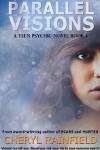
Seeing danger during dangerous episodes themselves.
Publisher: (self-published)
Pages: 56
Type: Fiction
Age: Young Adult
ISBN: 978-0-9878460-1-3
First Published: 20th November 2012
Date Reviewed: 11th December 2012
Rating: 5/5
Kate suffers from asthma, yet whilst her attacks are frightening and sometimes life threatening they enable her to have visions of the past, present, and future. Despite these visions having proved true to life on certain critical occasions, her family still do not take her seriously, but when she begins to witness domestic violence in her sister’s marriage, and the death of her new friend’s depressed sibling, Kate finds she can no longer remain a passive spectator.
Parallel Visions is a short and easy read (in terms of the writing itself) that manages, partly because of those two aspects, to present and highlight vastly important issues with the aim of helping those who struggle in similar ways.
The words and plot are simple, and the novella is very much a YA book, with all the trappings of stories for that age group – love and school problems and the like. In fact if the subject was different it would be a bad thing, but because of the message it works extremely well. People need to read and be assisted by guidance they will understand and relate to and thus the book succeeds in its implied aim. However the book isn’t just for those who have issues in their life and the approach is such that it serves as an introduction, too.
Interesting is the way the paranormal aspect, of seeing oft-prophetic visions whilst suffering an asthma attack, is used. On the face of it, such an aspect is hideous, a girl only being able to see visions when in a critical state, but it could be said that, whether intentional or not, Kate’s suffering amplifies the suffering of those she sees. And the way Kate responds, in her chosen need to see the visions, demonstrates the way people put others before themselves despite danger. And at a basic level the way the necessary situation for the visions to happen echoes, to extent, such phenomenon as the recently dead coming back to life proclaiming to have seen Heaven – the way the miraculous attends sadness.
That Kate’s parents do not believe in her visions sounds unrealistic until you remember that most people tend to be suspicious of the paranormal. The reader may wonder why they didn’t believe her after she was right the first time, however, and how they weren’t receptive of the idea that Jenna was being beaten. This is an interesting, nay, important issue to consider, even if it is different than many statements for the visions, highlighting the worries that attend a situation that may or may not exist, and the underlying problems that appear to support suggestions, and perhaps also the extent to which people are afraid to cause a fuss. Rainfield does a brilliant job at reminding her readers that issues and people are rarely black and white, that things may not be what they seem. Yet she doesn’t simply demonise those in the wrong – in addition to explaining appearances she also takes a look into how people believe they are behaving as well as why they might become that way. And in the case of Gil’s sister she shows that a person can heal but unless they have the necessary support that healing may not last or be strong enough.
In a very short time Rainfield manages to offer a lot of support to those of an age group (in fact more than one group, really) that often does not get such support from elsewhere. The work of a writer of clear prose, bearer of a lot of love and understanding, and a good storyteller, Parallel Visions is far more than just a book you read and finish and with various lessons and messages to hear for different readers.
I received this book for review from the author.
Related Books
None yet.











